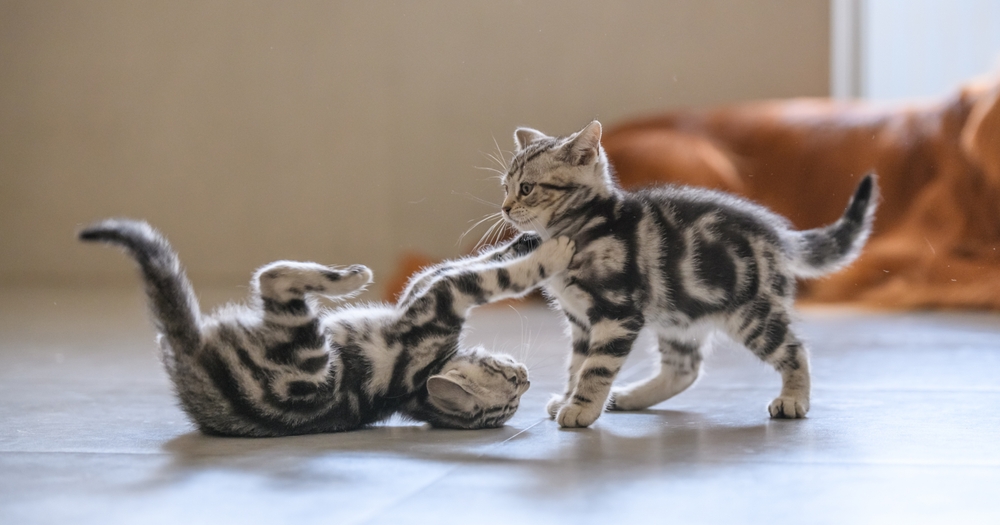Adopting a kitten is exciting, but the adjustment can be stressful for your tiny feline friend. Our Lytle Veterinary Clinic team wants to ensure you and your kitten have a long and successful relationship, and we provide tips to welcome your new feline friend to help make the transition easier.
#1: Gather your kitten’s supplies
Preparing for your kitten begins before you bring them home. Ensure you have everything your fierce feline needs before they arrive. Kitten essentials include:
- Food and water bowls
- Veterinary recommended kitten food
- Low-sided litter box and litter
- Cat carrier
- Scratching posts
- Cat toys
#2: Kitten-proof your home
Another critical step before your kitten arrives is kitten-proofing your home. Kittens are adorable, but they can be agents of chaos, wreaking havoc throughout your home. Considerations include:
- Linear objects — Remove all linear objects, such as twine, shoelaces, strings, and ribbons, which can cause a linear gastrointestinal (GI) foreign body if ingested.
- Unstable surfaces — Kittens love to explore by climbing and jumping. Block access to or secure surfaces so they won’t topple if your feline friend finds their way to the top.
- Electrical cords — Some kittens enjoy chewing on electrical cords, which could result in a shock or fire hazard. Hide all cords or use cord covers to secure them.
- Hiding places — Block access to hiding places where your kitten could get stuck.
- Plants — Some popular houseplants, especially lilies, are toxic to cats. Ensure any plant you have in your home is cat-friendly.
#3: Create a kitten-safe area
Having access to your entire home can be overwhelming for your tiny kitten. Designate a room as your kitten’s area while they adjust to their new environment. Ensure they have all the resources they need, including food and water, litter box, comfortable bedding, scratching post, and toys, and let them acclimate to their new home for two to three weeks. Spend as much time with your kitten as possible during this period. Sit quietly with them as they explore, and once they get more comfortable, use interactive toys to play with them.
#4: Socialize your kitten appropriately
Your kitten’s socialization should begin before you bring them home, and you should continue introducing them to new sights, sounds, and experiences to help them learn how to adapt. This helps them grow into well-adjusted adult cats.
#5: Introduce your kitten properly to other pets
If you have another pet in your home, you must take care to introduce them properly to your new kitten so the relationship is successful. Tips include:
- Feeding your kitten and your other pet on separate sides of a closed door.
- Exchanging their bedding so they get used to each other’s scent.
- After a couple of weeks, letting your kitten explore the rest of your home while confining your other pet.
- Letting your kitten meet your other pet through a secure barrier, giving each treats to make the experience enjoyable.
- As long as neither pet shows aggression, letting your kitten and other pet interact, supervising them until you are certain they get along.
This process can take several weeks, so patience is necessary. If you try to rush things, you could end up with permanent discord between your pets.
#6: Ensure your kitten’s litter box setup is acceptable
Kittens typically learn how to use a litter box at an early age, but if their litter box setup isn’t acceptable, they may find other places to do their business. Considerations include:
- Placement — Place the litter box in an easily accessible, low-traffic area where your kitten won’t be disturbed while using it. For example, don’t place the litter box in the basement next to the washing machine, which may produce noises that scare your tiny feline friend.
- Number — You should provide at least one litter box for every cat plus one extra.
- Litter type — Most cats prefer about one to two inches of unscented, clumpable litter.
- Cleanliness — Cats are hygienic creatures, and they may avoid a dirty litter box. Scoop the litter at least twice a day, and completely clean the box and replace the litter at least once a week.
#7: Provide scratching posts for your kitten

Scratching is a necessity for cats, allowing them to stretch, relieve stress and boredom, and maintain their claw health. If you don’t provide appropriate scratching surfaces, your kitten will use your furniture, curtains, and carpets instead. Things to consider include:
- Type — Cats have different scratching preferences. Provide vertical and horizontal scratching posts with different surfaces to determine your kitten’s scratching preference.
- Number — Ensure every cat in your home has their own scratching post, and provide a few extra if possible.
- Location — Place scratching posts in areas where your kitten likes to play and rest as opposed to out-of-the-way locations. If your kitten scratches an inappropriate surface, use a scratching post to block their access to the area.
#8: Schedule your kitten’s first veterinary visit
Once your kitten settles in, schedule a veterinary visit with our Lytle Veterinary Clinic team so we can ensure they receive the necessary vaccines and start the appropriate parasite preventives. This helps us establish a relationship with you and your feline friend so we can keep them as happy and healthy as possible throughout their life.
If you’ve recently adopted a cute, cuddly kitten, contact our Lytle Veterinary Clinic team so we can meet your new tiny feline and get them started on an appropriate health care plan.







Leave A Comment